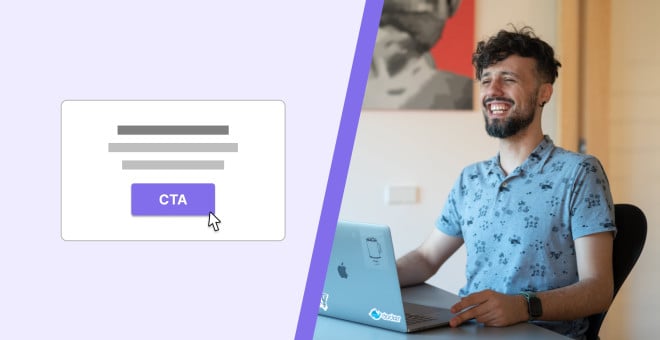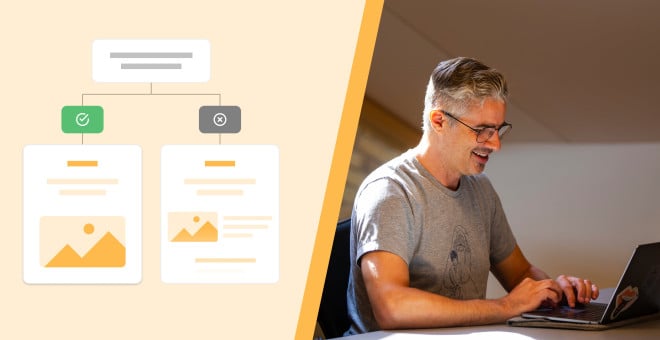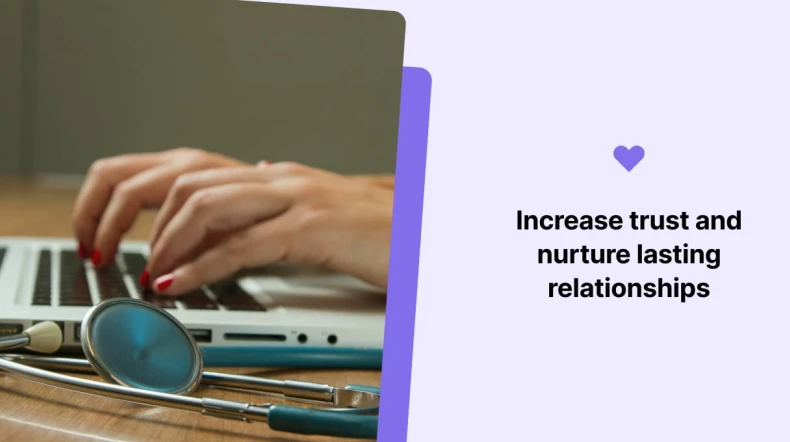How to successfully close deals with email marketing for real estate agents

Being a successful broker or agent is all about maintaining and growing your client base. Whether you’re at a viewing, a dinner party, a meet-up or any other social event; you know you’ve got to make a name for yourself.
But how can you possibly nurture relationships with everyone you meet along the way?
Email marketing for the real estate industry is the answer. See it as your personal Siri (or Alexa).
This effective marketing tool helps you save, sort and segment your contacts. You’ve got full control over your list and the message you want to get across. Automated email marketing campaigns deliver the right message to the right person, while you’re busy finding new homeowners for the beautiful properties you’ve got to offer.
When using real estate email marketing the right way, you can reach more people and close more deals.
In this email marketing guide, we’ll show you how to capture leads, establish long-lasting relationships, close deals and keep in touch with new homeowners and happy sellers.
Why use email marketing for your real estate business?
Real estate is all about relationships, even after the final transaction has been made (40% of buyers find an agent through referrals from past clients, after all)! Email marketing lets you nurture your client base so that they come back to you for their next purchase, and/or refer their network to you as well.
Since the global pandemic, these digital interactions have become more important than ever. People are now more open to a virtual shopping experience, so realtors who use email to promote updates, videos and blogs will note a marked increase in engagement. In fact, our 2021 industry benchmark report found that since 2018, real estate email open rates have increased by 32%, and click-through rates by 54%!
However, only 35% of real estate agents say they feel confident about their online marketing skills. Fortunately, there are plenty of straightforward email marketing best practices to broaden your reach and get those conversations flowing.
The major perks of using an email tool
An email marketing software will give you the structure and efficiency to successfully run your real estate business.
The major perks of using an email tool include:
Collecting new leads and clients with ease
Building long-lasting relationships within your community
Establishing your own brand and reputation
Growing your sales with well-timed emails
Saving time and manual work with email automations
Encouraging referrals after a deal has been closed
The bigger your client base, the more your business will thrive—and maintaining a healthy, engaged email list is a surefire way to get there.
Picking the best email tool for you
Working as a real estate agent or broker is all about your network and how well you can attain and maintain relationships. Since you can only plan so many real-life coffee meetups in one day, a lot of conversations will happen online. Email marketing makes this easy.
With so many contacts, different properties and demanding clients to handle simultaneously, your email tool should offer:
Signup forms: These will automatically collect and organize new leads for you, directing them into groups and segments of your choosing for a more personalized experience for subscribers.
Segmentation: This is where you group subscribers based on dynamic characteristics such as geographical location. This will nurture the customer relationship and build trust, as you can send emails that perfectly fit their situation.
Subscriber groups: Groups can be updated manually, and you can create groups for things such as sellers vs. home buyers, property locations or features, budget, renting vs. buying, and family size. Targeted emails increase your sales and boost your credibility. Offering people email content that’s actually valuable for them makes them trust and value your services.
Email automation: You can automate most of your standard emails, such as welcome emails, viewing follow-up messages, or check-in emails for happy buyers. Set them up once, and then they’ll do all the hard work for you! You just need to jump in every now and then to check the engagement and see where people need additional information or help.
Branding: Your emails are your vehicle to having one-on-one conversations with new leads. With each email you send, you can show your personality and convince new subscribers that you’re the broker that’ll make their property dreams come true. For this, you need an easy-to-use email builder which lets you design beautiful newsletters that reflect who you are.
How to set up your real estate email marketing the right way
Setting up your real estate email marketing strategy is easy. Just follow these 4 steps!
1. Capture real estate leads
At your next open house, networking event or another sociable get-together, you can collect email addresses the old-fashioned way (just remember to get consent to use their personal information for the purposes of email marketing) or use an iPad app to add people directly to your real estate email list.
Though property viewings and sales mostly happen in person, you’ll want to also take your business online for efficient lead generation and to build your client base further.
Online, you can reach people by using targeted paid ads (on Google or social media) and have the right people find you by investing in SEO for relevant keywords (e.g. real estate broker in [city]).
PPC advertising can get really expensive very quickly! So we wrote a guide about how to drive traffic to your website or property listing pages with online ads.
Active on social media? Add a subscription tab on your social media profile with the Facebook integration.
Once people land on your website, it would be a shame to let them go without asking for their contact details. One can always try! In email marketing, you do this with a signup form.
A signup form can be placed in various spots on your website, from the footer to the blog sidebar or appearing as a pop-up.
Give visitors a good reason to give you their email addresses. Tell them what they can expect from your real estate marketing emails, and explain how it’s relevant to them and how it will benefit them.
We explore how to grow a high-quality prospect email list in this in-depth guide.
Many real estate marketers use an incentive to motivate visitors to sign up. In exchange for an email address, they offer a useful gift that is relevant to the real estate market, such as:
A report on real estate price changes
How to obtain low-interest loans
A list of contact details from movers and packers in the area
A checklist for moving properties
As tempting as it might be, don’t buy an email list or send emails to any other list you've obtained without actually getting the subscriber's permission. The leads on these lists are low quality and often include faulty or non-existent email addresses. If you send emails to these lists, you will experience:
Terrible open and click rates, as these people are likely not interested in what you have to say
High chances of being flagged as a spammer, which could get you banned
Hurt sender reputation and deliverability (meaning that you won’t make it to the inbox anymore). 😬
Real estate agent Jaclyn Konopka gives away a seller’s brainstorming guide to attract new subscribers in her beautiful email.
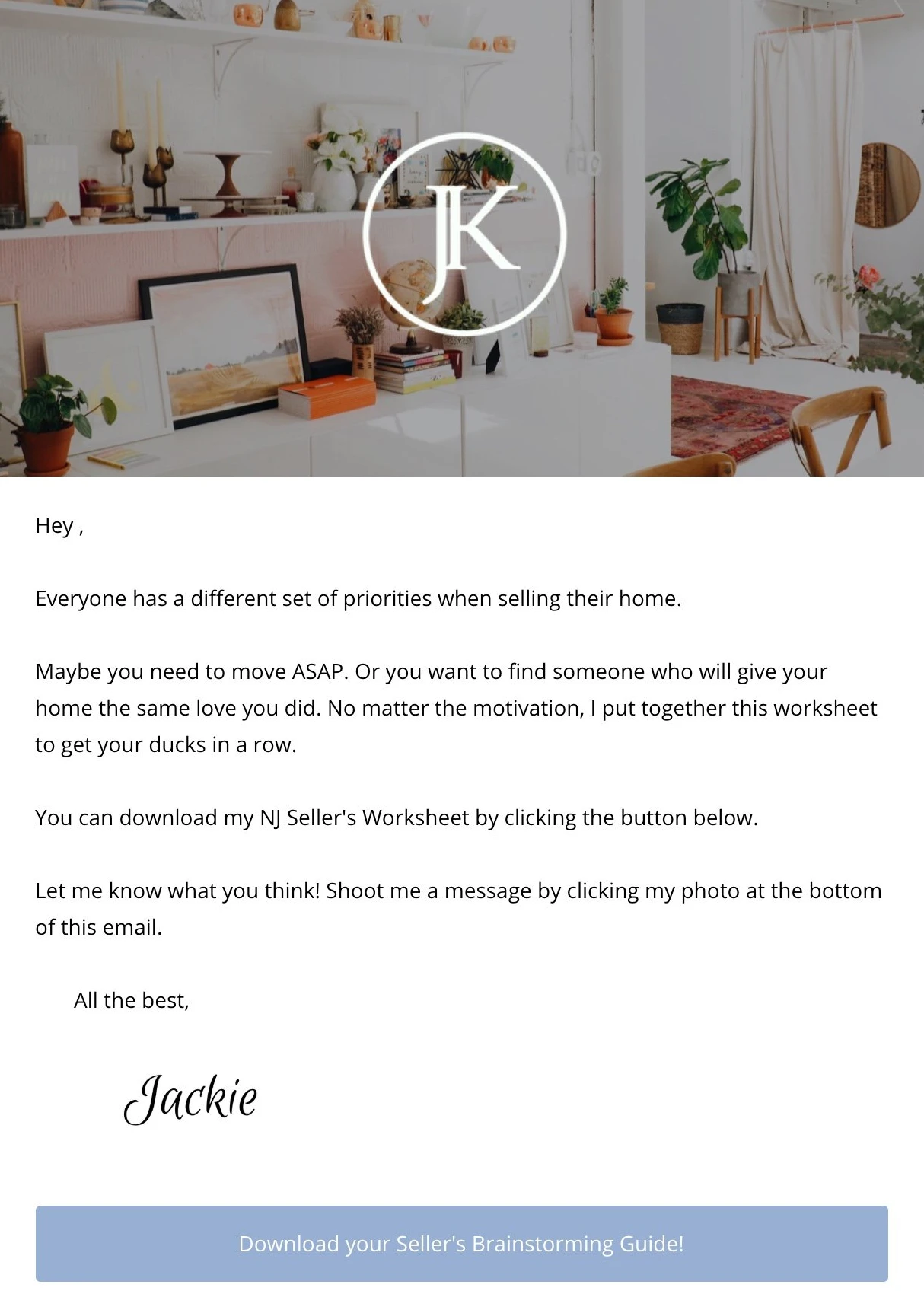
2. Brand yourself
Just like normal, offline relationships, you want to break the ice and build rapport before you ask for any favors or promote your services. Work on your credibility first, then start doing business.
Welcome email
To break the ice, use an automated welcome email. This email is sent after someone signs up for your list. You can send it immediately, or add a couple of hours (or a day) of delay in your automated workflow. Your email marketing software will handle these autoresponders.
In the welcome email, you introduce yourself. It’s your first chance to show your level of expertise, trustworthiness, experience and professionalism. Focus on why customers should do business with you (and not another one of the many brokers in town).
Then add a call-to-action (CTA) that asks the reader to set up a phone call or grab a coffee to chat about their situation. Preferably, you want every email to contain a call to action (and your phone number).
Here's how to create a call-to-action (CTA) that works in your real estate newsletters.
HousingWire welcomes new members with a short introduction. Their email newsletter then goes on to share their insights into the real estate world, with a clear CTA to help people “up their game”!
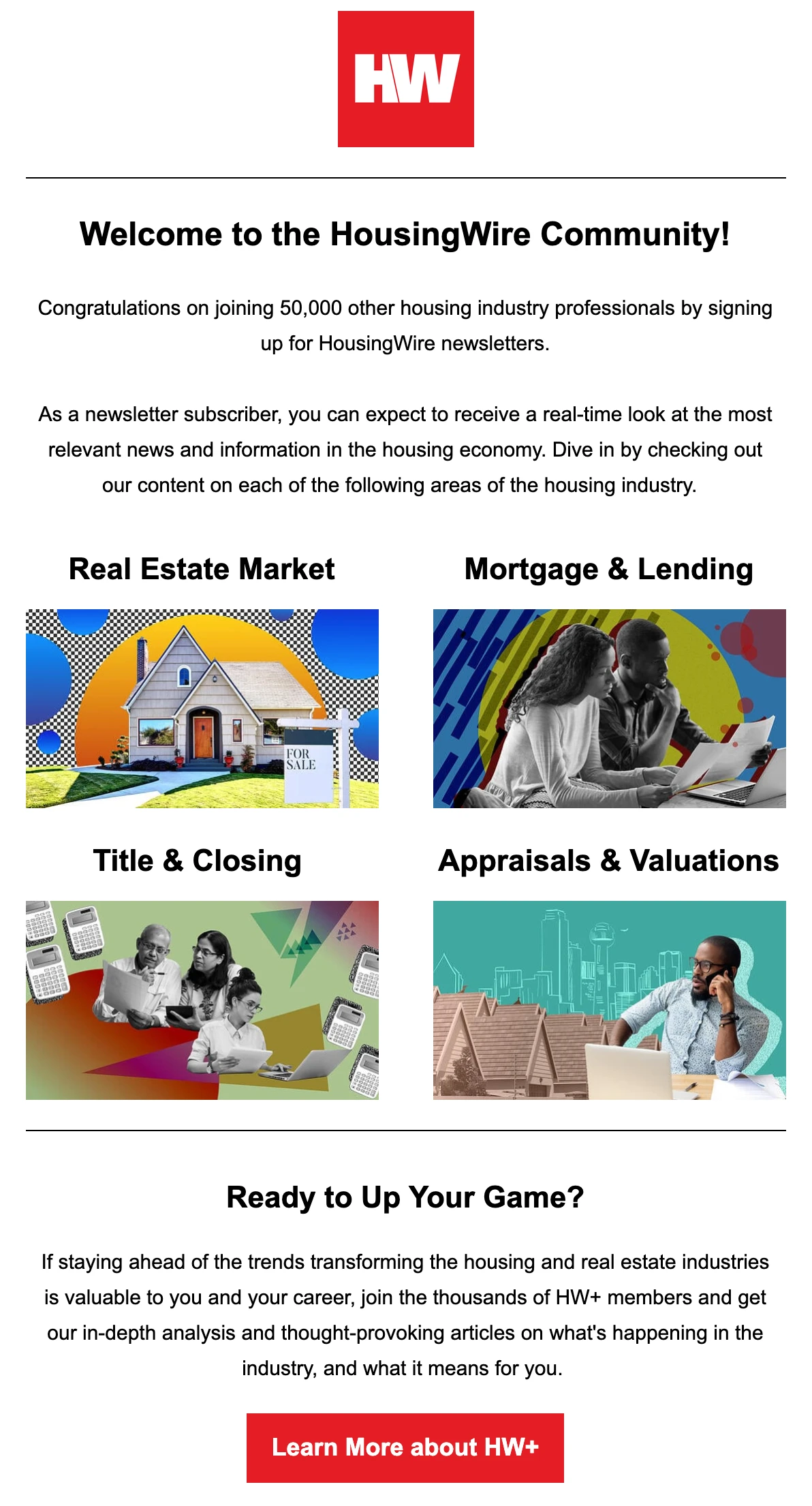
Entertaining emails
For the first set of emails, don’t instantly go into sales mode. There’s plenty of time for that later! Instead, show your human side and personality.
Send your subscribers emails about:
Local charities you participate in
Events happening in town
Updates on interest rates on the market
Periodic comparative market analysis
Newly opened shops and restaurants
Holiday greetings
Home improvement tips
Mortgage news
Housing decoration inspiration and trends
Redfin brings value to their readers with their home buying classes, price range calculator and local market filter.
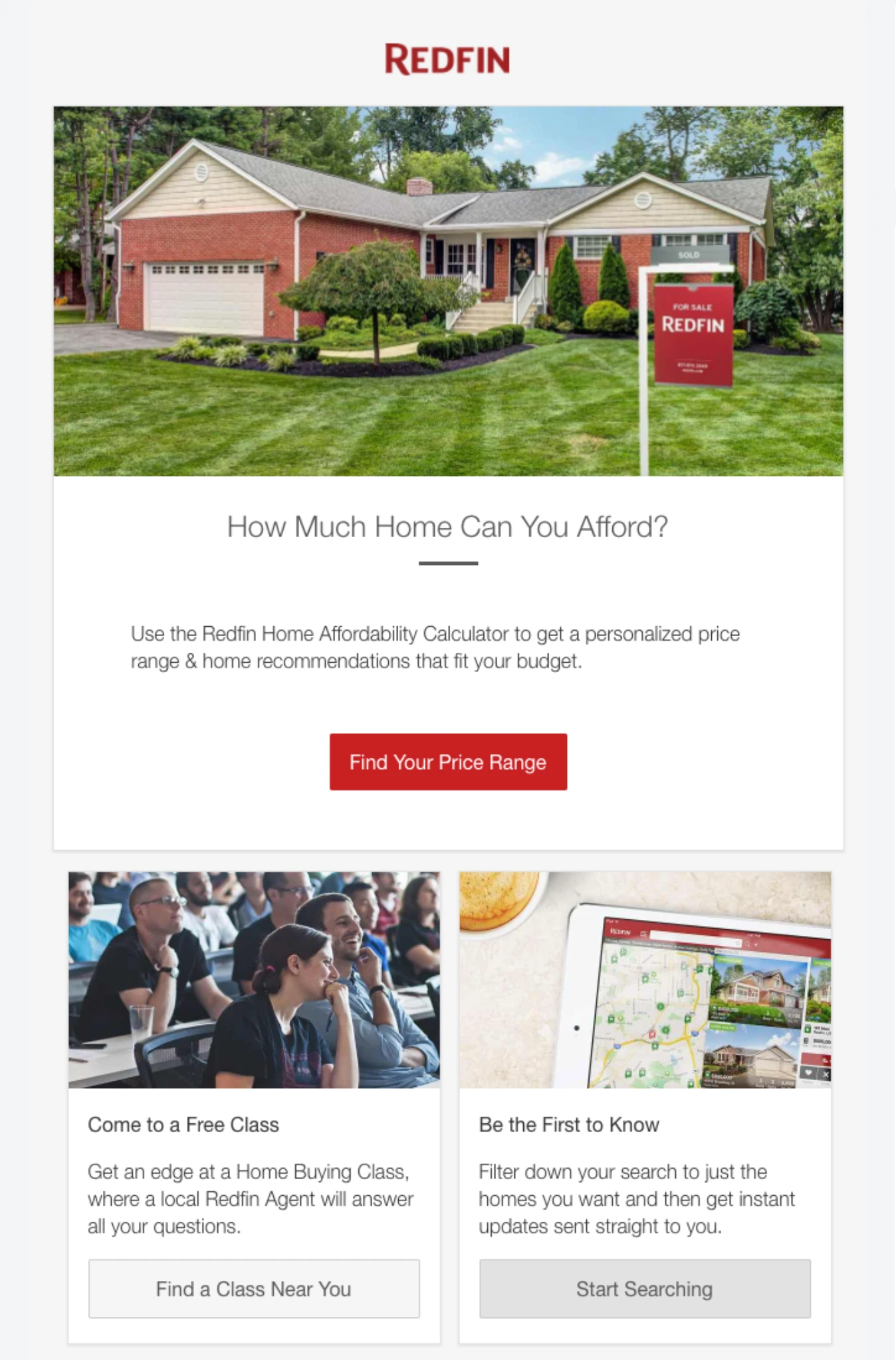
3. Invest in a personal relationship
Should I let you in on a secret that’ll instantly make your emails more valuable?
It’s personalization.
Find out as soon as possible what your email newsletter subscribers are interested in so you can personalize your messaging and deliver value. This starts on your homepage. Set up different landing pages for different target groups.
Need some good examples of real estate landing pages? Why don’t you browse through the ones our clients have made!
People interested in selling their house don’t need the same information as those who are looking to buy one. The same goes for visitors searching in different locations or with diverse housing needs. When you have different landing pages, each target group can read about what’s applicable to their situation.
Look at this example from Wilkinson ERA Real Estate, their email targets newly-weds and puts a fun spin on saying "yes to the dress" with "yes to the address".
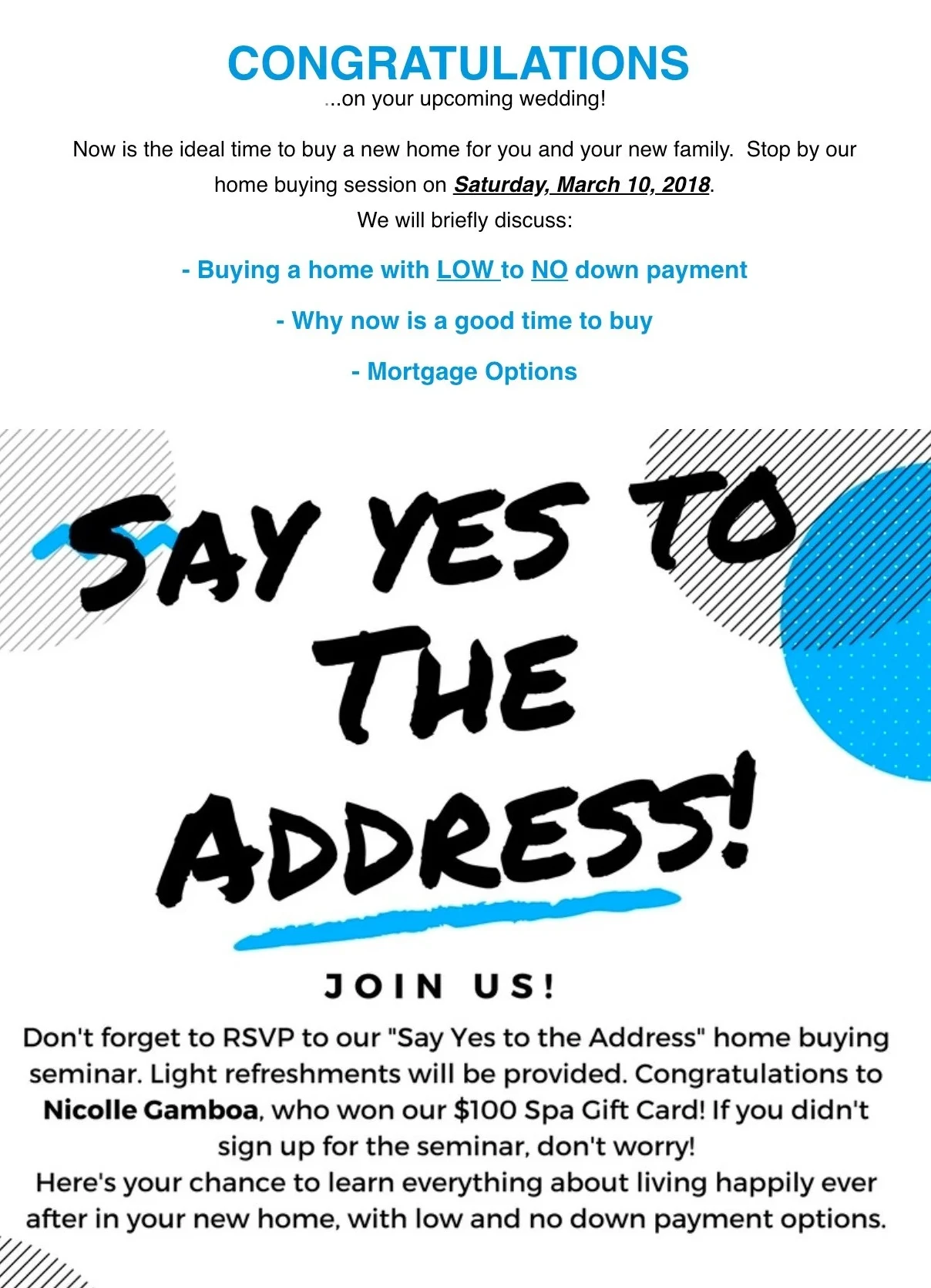
Use different signup forms on each landing page to organize your readers from the get-go.
Or use one signup form and have people mark the newsletters they’re interested in. In your email tool, these subscribers will automatically be grouped together, making it easier for you to send personalized emails. At MailerLite, we call this signup form feature interest groups.
And if you want to find out more about your existing subscribers? Use surveys.
At MailerLite, customers can easily implement customizable surveys in their emails. This makes it easy for subscribers to quickly answer your questions directly within the email. The results can be tracked within the software and based on what customers answer, new subscriber segments can be made.
4. Stay top of mind with targeted emails
After you’ve grouped your subscribers together in different segments, it’s time to come up with a concept for the real estate emails you’ll send out. To make the most out of your email marketing, try to automate as many emails as possible.
You’ll want to have a mix of regular email marketing campaigns and automated workflows.
Regular campaigns could include:
Just sold properties
New or expired listings
Current events in town
Seasonal information
Updates
Seasonal events and festivities are a good excuse to host something for potential buyers and sellers. You could also host a giveaway or competition to build up the hype, just like Trulia did in their email campaign below.
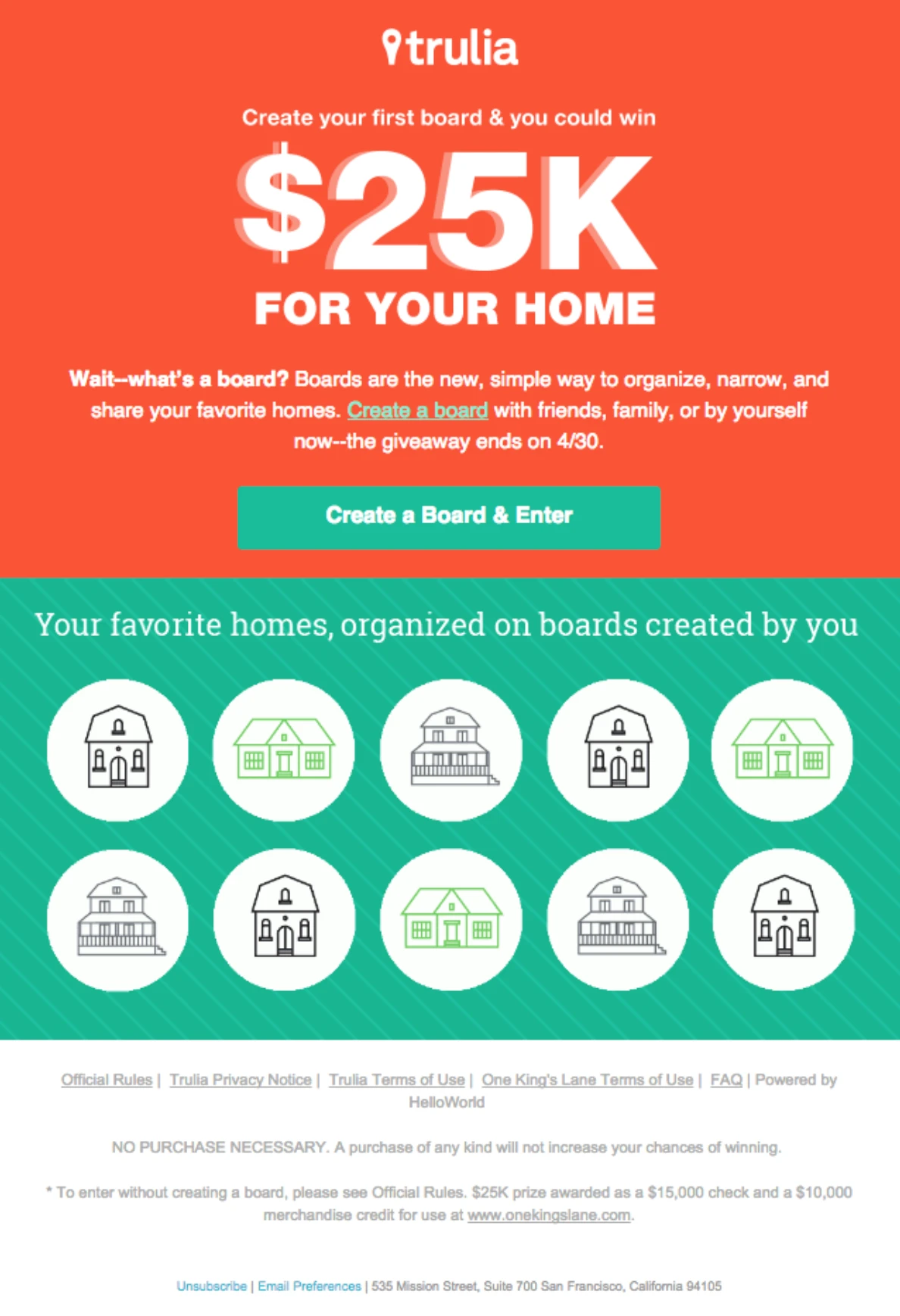
Automated workflows you could set up include:
Incentive email (e.g. when a subscriber signs up to receive a downloadable)
Welcome email
Relationship-building emails (a series of emails in which you introduce yourself, your service and what you can offer the subscriber)
Automated new listing alerts or a weekly/monthly round-up of what’s new on the market using RSS campaigns
Follow-up email after a meeting, viewing or sale
Referral or testimonial email for happy buyers
Drip campaigns (a series of emails to nurture customers, e.g. to get them from explorative to ready to buy)
Win-back campaigns for readers that haven’t shown any engagement with your emails lately
Automated email sequences are easy to implement with the right email marketing software. This guide explains what email automation is and why you’ll love it.
This is a good example of a helpful email. Authentic Form & Function shares the latest news on real estate design and technology, with links to their blog and podcast.

To get you started, we’ll introduce you to the real estate email campaigns that’ll bring your clients closer and increase the number of contracts you’ll print this month.
Real estate email campaign ideas to set up today
Just like the housing market, your emails are also ever-evolving. Get creative and play around with refreshing newsletter content and different types of emails that your target group will be keen on reading. To form a good base, here are some ideas for email campaigns that are good to set up.
No worries, our newsletter gallery offers plenty of email templates to get you inspired. You can copy them, adapt them to your personal design and add your own email content.
👉 In our email template gallery you can see how our customers design their email newsletters.
Emails for buyer leads
Let’s start with a simple real estate email marketing campaign. Some people passed the exploration phase and don’t need all the extra fluff in their real estate emails. They’ve got their money sorted and are ready to buy. Offer buyer leads the opportunity to sign up for an email list that’s dedicated to their needs. Send out sneak peeks, integrate video tours and give buyer leads the opportunity to schedule an appointment (preferably directly online using a booking system).
For these emails, it’s important to show listings that fit the buyer’s criteria. You can either ask about their preferences directly on the signup form, or send a welcome email in which the reader is encouraged to fill in their user profile to enjoy better recommendations.
This is how HB & CO. Real Estate shows its beautiful listings.

Emails for seller leads
Sellers expect different things from their real estate newsletter than people who are in the market to buy. Tag this subscriber group and send targeted information about the housing market, the location they’re selling in, any increase or decrease in their home value or what homes around them sold well in the past month(s).
To gain more trust and to position yourself as an expert in your field, showcase what homes you’ve recently sold. This gives the seller proof that their property is in good hands with you.
In the example below, Zillow gives statistics to back up their expertise in the real estate market, including stats on the number of homes they’ve listed and sold recently.
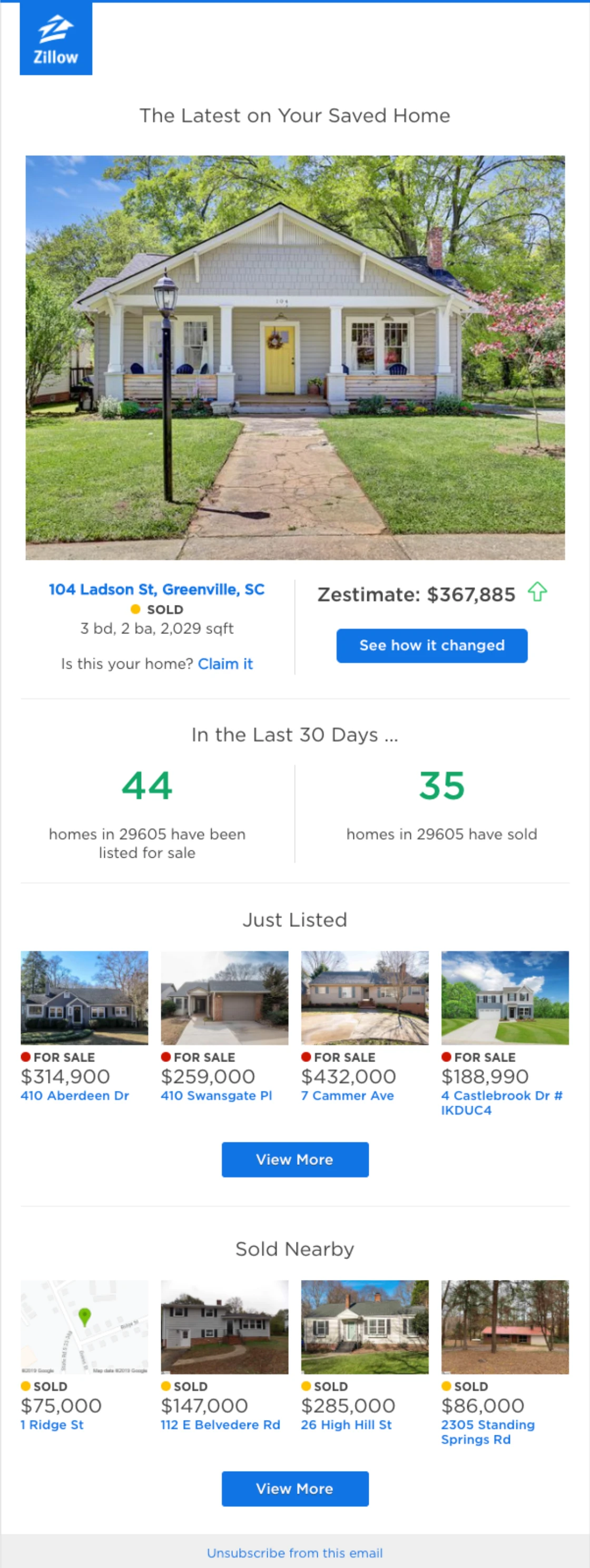
Behavior-triggered emails
These types of emails are automatically sent out when certain behaviors are triggered.
For example, you send out an email with 5 new listings in New Orleans. Jeanne reads your email and falls in love with a colorful house with a huge front porch. She clicks on the listing to find out more about the property. By clicking the link, you can activate a behavioral trigger that automatically sends out a viewing invitation for that specific house.
Behaviors can also be used for prices. Ask readers in an email what budget they have available for their new home. Use the survey option and tag readers automatically based on their answer. Then send emails featuring real estate in their price range.
In this example from Trulia, subscribers get a better idea of what type of houses are available within their budget. We love their interactive quiz-like approach.
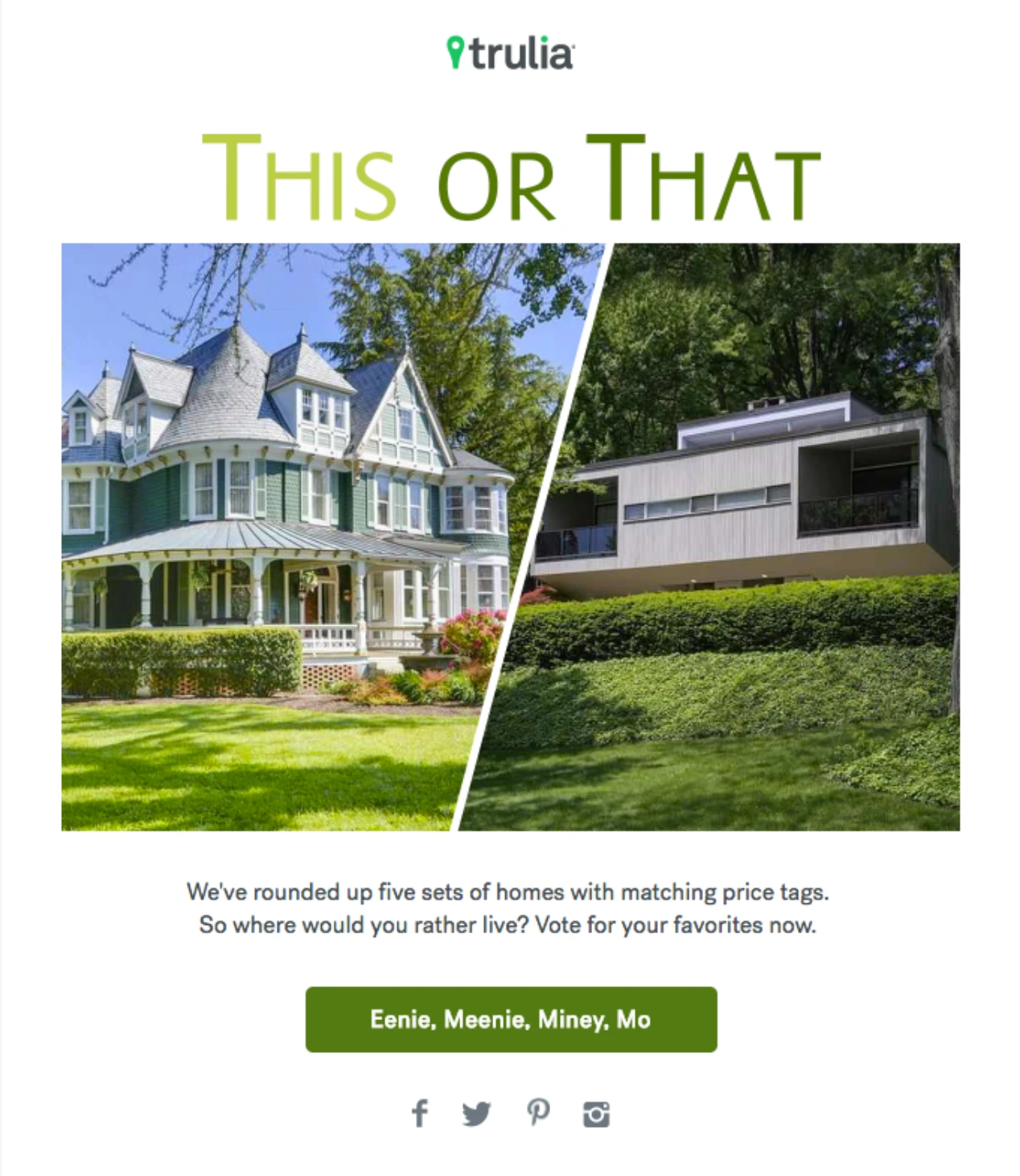
Follow-up emails
We all get excited when people remember things, whether it’s our birthday or to ask how that important meeting went. It shows you care!
With email automation, you don’t need to have a dolphin memory to keep track of your customers. You can automate follow-up emails after each viewing (either sent directly or using a delay of some hours or a day). Ask people what they thought of the property, whether they have any remaining questions or need additional information.
Another good follow-up email is one that’s sent about a week after a client closed on a house. Check in, see how the move went and ask if there’s anything you can do to help with the transition.
You can then even add a condition that sends out another email to those who haven’t clicked through your first follow-up email. Or add a delay and send out a reminder, urging viewers to show their interest before the property is off the market.
And what if you’ve sold the property? Be tactical about it, communicate they’ve missed their chance this time but offer similar properties in the neighborhood.
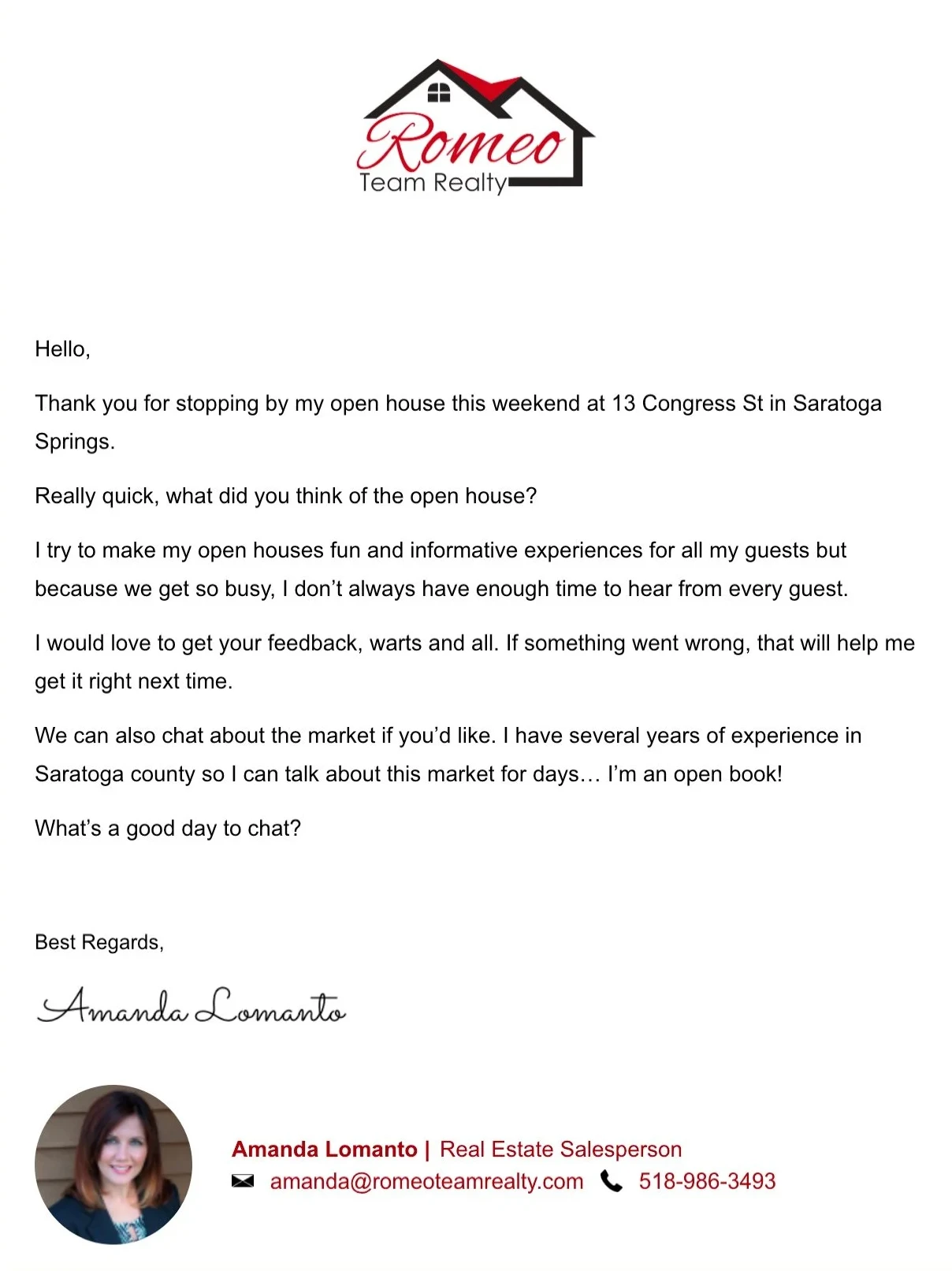
Referral emails
Client reviews build your credibility. It’s good to ask for feedback during the time you work together or when a deal is closed.
After a successful deal—for example, 1 to 3 months later—it’s nice to stay in touch with the happy new homeowners or sellers. To build your portfolio and increase your credibility, you can ask for a referral. Then use these online reviews and testimonials in your email copy.
Referral emails are also great to use for your industry partners, like lenders and attorneys. Was the partnership pleasant for both parties? Why not send out an email to partners to ask for a mutual referral. Maintaining these relationships is equally important as keeping in touch with clients.
The Pohlman Group already asks for reviews and Facebook connections early on, actively broadening their online presence. Their email subject line makes it clear what it wants from the client.

Broker Kendahl McIntyre even rewards referrals, sending out a thank you message with a voucher gift.
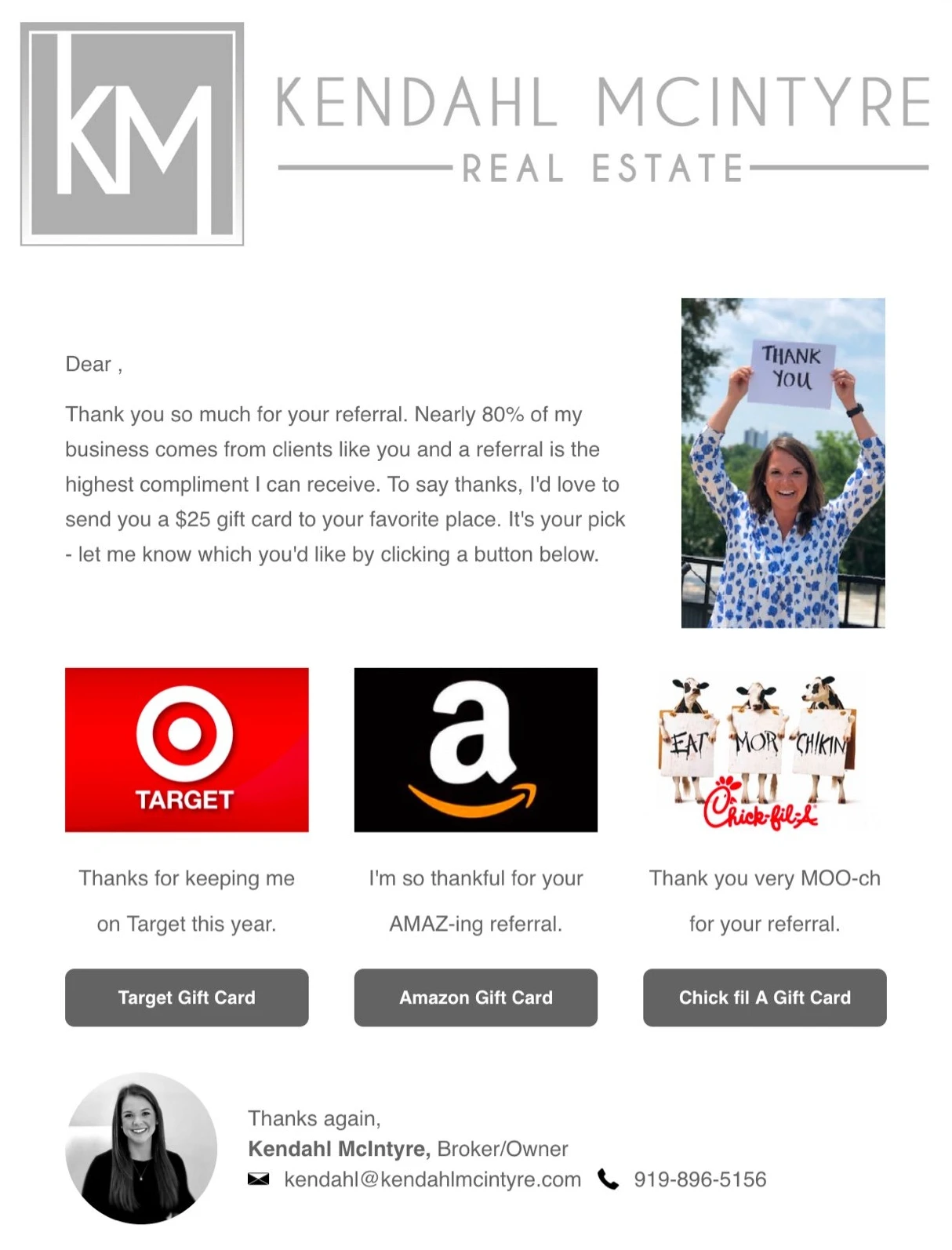
👉 Tip: Don’t forget to move buyers or sellers to a separate group so they don’t receive your listing emails anymore. Instead, offer content suitable for their interests.
4 best practices for real estate email marketing
When sending out an email, try to think about what you want to achieve. Do you want to get to know the subscriber better? Arrange a call? Collect RSVPs to your open house?
This call to action should be the main focus of your email. Make it easy for your clients to understand what’s expected of them. Make your CTA button large enough to function properly on a mobile device display and give it a color that’s hard to miss in your email design.
Selling property is your core business, but don’t make this the focus of every sent email. Think of alternative ways to add value. If you solely send out new listings, there’s little room for the customer to get to know you. With so many agents fighting for their spot in the real estate world, it’s important to invest in personal connections that can grow into a long-lasting business and praising referrals.
Always choose quality over quantity. If you want to do your email marketing right, don’t farm email addresses from local boards or NAR (or anywhere where you didn’t obtain consent). Sending out unsolicited emails is considered spam and will get you suspended from your email software and hurt both your online and offline reputations.
Save time by having your email responses pre-written and ready to go. For example, you could draft a follow-up email in advance with the text:
“Hello [name],
“I’m just checking in to see if you’re still interested in selling your property at [location name]? We have several buyers who are looking to purchase in this area, so this could be the perfect moment to list your home.
“Let me know if you have any questions.
“Kind regards,
“[Name]”
That way, whenever you have a new lead, you’ll be able to quickly enter their details and hit ‘send’, confident that the right message will hit home.
Closing off
Email marketing offers real estate agents and brokers the opportunity to collect more leads, nurture relationships and eventually seal more deals.
Tag and segment your subscriber base to send them relevant content
Use automation to connect with multiple people simultaneously
Show your unique brand personality and voice
Consistently add value with your emails
When you follow these best practices, your email marketing will nurture those client relationships, while you can get on with showing properties. Easy and effective!
And when your customers find your emails valuable and you connect with them personally, they’ll be much more likely to do business with you.
How are you going to seal the deal with email marketing for your real estate business?
Create your first real estate campaign in minutes!
Our free plan includes advanced features like ready-made newsletter templates, email automation and much more.


